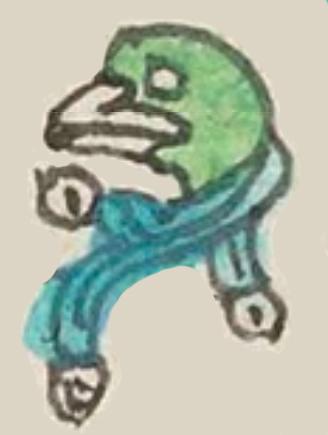Atototl (Mdz2r)
This compound sign is a personal name of a male Aztec lord, Atototl. The glyph is comprised of two elements, atl (water) and the head of a tototl (bird), referring to a water bird. The bird is shown only as a head, in profile, facing left. While the eye and beak are left uncolored, the head is otherwise green. The water (turquoise blue, with wavy lines showing movement, and white droplets/beads and turbinate shells coming off the flow) swirls around the head of the bird and then downward to the left.
In the historical context image, the man sits on a green, tied bundle, he wears a plain white cape that covers not only his body but his uplifted knees. He has bare feet that stick out from underneath the cape. He wears an earplug that his the same tan flesh tone as his skin. He has short bangs with hair down to his shoulders, and at the top of his head is a ponytail (tzontli)?] standing straight up. It is wrapped and tied in a red leather thong. He sits in profile, looking to the viewer's left.
Stephanie Wood
This lord was among those who elected Tenuch (Tenoch) as their leader. While this is a man, Atototl was also a name given Nahua women. Small like a sparrow, it was common at the lakes surrounding Mexico-Tenochtitlan according to the Histoire naturelle, générale et particulière (1799, 110). But in contemporary Eastern Huastecan Nahuatl the atototl is a heron (garza, in Spanish); https://nahuatl.wired-humanities.org/content/t%C4%93nchopichtli, and the Gran Diccionario Nahuatl gives "pélican." In the sixteenth-century this bird had a formidable association as "a drowner of people" (Sahagún, Florentine Codex, Book 11), which may thereby add potency to the lord's name. Some naming books say that atototl is "water converted into bird." The state of Jalisco has a town called Atotoniquillo.
Stephanie Wood
atototl
Atototl
Stephanie Wood
c. 1541, or by 1553 at the latest
Stephanie Wood
water, shells, birds, herons, pelicans, agua, caracoles, garzas, pelícanos, ave, aves, pájaro, pájaros, pluma, plumas

a(tl), water, https://nahuatl.wired-humanities.org/content/atl
toto(tl), bird), https://nahuatl.wired-humanities.org/content/tototl
atoto(tl), water hen, heron, pelican, https://gdn.iib.unam.mx/diccionario/atototl/41220 and https://nahuatl.wired-humanities.org/content/t%C4%93nchopichtli
"Water Bird" (Whittaker, 2021, 83); "Water Bird" (Berdan and Anawalt, 1992, vol. 1, p. 233)
La Garza o El Pelícano
Stephanie Wood
Codex Mendoza, folio 2 recto, https://digital.bodleian.ox.ac.uk/objects/2fea788e-2aa2-4f08-b6d9-648c00..., image 14 of 188
The Bodleian Libraries, University of Oxford, hold the original manuscript, the MS. Arch. Selden. A. 1. This image is published here under the UK Creative Commons, “Attribution-NonCommercial-ShareAlike 3.0 License” (CC-BY-NC-SA 3.0).





